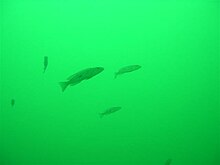
A tuna is a saltwater fish that belongs to the tribe Thunnini, a subgrouping of the Scombridae (mackerel) family. The Thunnini comprise 15 species across five genera, the sizes of which vary greatly, ranging from the bullet tuna up to the Atlantic bluefin tuna. The Atlantic bluefin averages 2 m (6.6 ft), and is believed to live up to 50 years.

Herring are forage fish, mostly belonging to the family Clupeidae.

Tilapia is the common name for nearly a hundred species of cichlid fish from the coelotilapine, coptodonine, heterotilapine, oreochromine, pelmatolapiine, and tilapiine tribes, with the economically most important species placed in the Coptodonini and Oreochromini. Tilapia are mainly freshwater fish inhabiting shallow streams, ponds, rivers, and lakes, and less commonly found living in brackish water. Historically, they have been of major importance in artisanal fishing in Africa, and they are of increasing importance in aquaculture and aquaponics. Tilapia can become a problematic invasive species in new warm-water habitats such as Australia, whether deliberately or accidentally introduced, but generally not in temperate climates due to their inability to survive in cold water.

The slender glass lizard is a legless lizard in the family Anguidae. The species is endemic to the United States. Two subspecies are recognized. The lizard was originally believed to be a subspecies of the eastern glass lizard. Their name comes from their easily broken tail which they can break off themselves without ever being touched. It is difficult to find a specimen with an undamaged tail. The lizard eats a variety of insects and small animals, including smaller lizards. Snakes and other animals are known to prey on the species. Humans have a part in destroying their environment and killing their food supply with insecticides. The lizard is considered to be a least-concern species according to the International Union for Conservation of Nature (IUCN), though it is vulnerable in Iowa and endangered in Wisconsin.
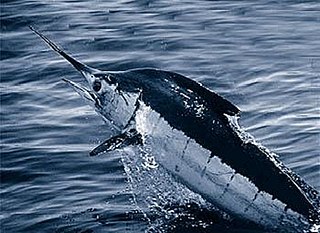
The term billfish refers to a group of predatory fish characterised by prominent bills, or rostra, and by their large size; some are longer than 4 m (13 ft). Billfish include sailfish and marlin, which make up the family Istiophoridae, and swordfish, sole member of the family Xiphiidae. They are apex predators which feed on a wide variety of smaller fish, crustaceans, and cephalopods. These two families are sometimes classified as belonging to the order Istiophoriformes, a group with origins in the Late Cretaceous around 71 million years ago with the two families diverging from one and another in the Late Miocene around 15 million years ago. However, they are also classified as being closely related to the mackerels and tuna within the suborder Scombroidei of the order Perciformes. However, the 5th edition of the Fishes of the World does recognise the Istiophoriformes as a valid order, albeit including the Sphyraenidae, the barracudas.
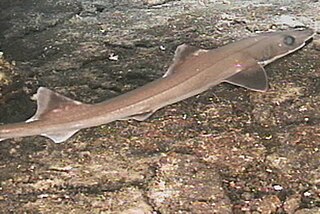
The slender smooth-hound or gollumshark is a species of ground shark in the family Pseudotriakidae. It is endemic to the waters around New Zealand, where it is usually found close to the bottom over the continental slope at depths of 300–600 m (980–1,970 ft). An extremely slim, plain brownish shark reaching 1.1 m (3.6 ft) in length, the slender smooth-hound can be identified by its broad, flattened head with a long, distinctively bell-shaped snout. Its mouth is angular with short furrows at the corners, and contains a very high number of tooth rows in both jaws. Its two dorsal fins are roughly equal in size.

The whitecheek shark or widemouth blackspot shark is a requiem shark of the family Carcharhinidae, found in the Indo-West Pacific Ocean between latitudes 34°N and 25°S. It can reach a length of 1 m. It feeds mainly on fish, cephalopods, and crustaceans. It is a viviparous species, with the female giving birth to up to four live young.
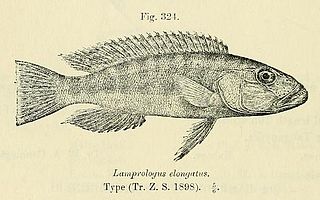
Lepidiolamprologus is a small genus of cichlids endemic to Lake Tanganyika in eastern Africa. It is closely related to Altolamprologus. and there is the possibility that a revision of the genus could see more species added.

The California slender salamander is a lungless salamander that is found primarily in coastal mountain areas of Northern California, United States as well as in a limited part of the western foothills of the Sierra Nevada, California, in patches of the northern Central Valley of California, and in extreme southwestern Oregon. This species resides primarily in a limited range within California as one of a handful quasi-endemic amphibians in the state.
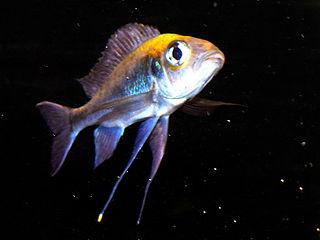
The featherfin cichlid is a species of cichlid endemic to Lake Tanganyika where it is found off rocky slopes. It feeds on plankton. This fish can reach a length of 21 centimetres (8.3 in) TL. It can also be found in the aquarium trade. This is currently the only species recognized in the genus by FishBase, but genetics and morphology suggest there are two valid species. The second is frequently called C. foae in the aquarium trade, but a review of the type specimen is needed to clarify if this is the correct name.

Lepidiolamprologus cunningtoni is a species of cichlid endemic to Lake Tanganyika where it prefers areas with sandy substrates in which it digs crater-shaped nests. This carnivorous species takes fish as prey. This species can reach a length of 29.1 centimetres (11.5 in) TL. This species inclusion in this genus has been questioned based upon its lacking many of the characteristics of its congeners. It can also be found in the aquarium trade. The specific name of this fish honours the British zoologist William Alfred Cunnington (1877-1958), who collected the type on an expedition to Lake Tanganyika.

Lepidiolamprologus elongatus is a species of cichlid endemic to Lake Tanganyika where it prefers rocky areas. This species is a carnivorous predator on fish. This species can reach a length of 32.5 centimetres (12.8 in) TL. It can also be found in the aquarium trade.
Lepidiolamprologus profundicola is a species of carnivorous, fish-eating cichlid endemic to Lake Tanganyika where it is found in rocky areas, avoiding areas with a sandy substrate, at relatively deeper depths than its congeners. This species can reach a length of 30.5 centimetres (12.0 in) TL. It can also be found in the aquarium trade.

Lobochilotes labiatus is a species of fish endemic to Lake Tanganyika. This species can reach a length of 36.8 cm (14.5 in), and can be found in the aquarium trade. It is currently the only known species in its genus.
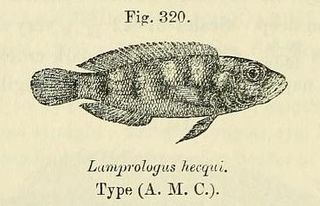
Lepidiolamprologus hecqui is a species of shell-living cichlid endemic to Lake Tanganyika. This species can reach a length of 8 centimetres (3.1 in) TL. This species can also be found in the aquarium trade. The specific name of this fish honours the Belgian soldier and anti-slave trade campaigner Lieutenant Célestin Hecq (1859-1910) who collected a specimen of the catfish Auchenoglanis scutatus in the mouth of which the type of this species was discovered.
Lepidiolamprologus meeli is a cichlid species in the subfamily Pseudocrenilabrinae. It is endemic to Lake Tanganyika, where it is found in the waters of Burundi, the Democratic Republic of the Congo, Tanzania, and Zambia.
Placodiscus attenuatus is a species of plant in the family Sapindaceae. It is found in Ivory Coast and Ghana. It is threatened by habitat loss.

The white sucker is a freshwater cypriniform fish inhabiting the upper Midwest and Northeast in North America, but is also found as far south as Georgia and New Mexico in the south and west. The fish is commonly known as a "sucker" due to its fleshy, papillose lips that suck up organic matter and aufwuchs from the bottom of rivers and streams.
